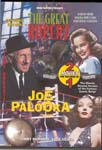

JOE PALOOKA
Comics and Films:
General:
Types of Comics:
Single panel
Sequential Art
(1) both are visual: audience may know visual images before the film is seen.
(2) panels like storyboards
(3) transition problems from shot to shot and in comics frame to frame.
(4) Many connections: Does the film in any way other than name and character cite the original art form?
The comic Joe Palooka was created by Ham FIsher as a result of interviewing a "palooka" - a heavyweight boxer. The strip ran from April 1930 until Nov. 24, 1984. Fisher used a number of story writerrs and illustrators one of whom, Al Capin produced his own strip - Li'l Abner who/which shares some characteristics with Joe Palooka
JOE PALOOKA
1934
Famous cast:
Stu(art) Erwin
Jimmy Durante
William Cagney (brother of Jimmy Cagney)
Robert Armstrong (King Kong)
Lupe Velez: Married to Johnny Weissmuller (Tarzan), affair with Gary Cooper and a final affair with a Vienna born actor named Harald Maersch. Velez was pregnant with his child and committed suicide. The public blamed him and his career was destroyed returned to Europe (other Mexicans Dolores Del Rio, Ramon Navarro
Thelma Todd: 115 films in very short career. Mysterious death White Hot: The Mysterious Death of Thelma Todd (T.V. Film)
There are at least 15 Palooka films along with a TV series.
1. Palooka (1934)
2. Joe Palooka, Champ (1946)
3. Gentleman Joe Palooka (1946)
4. Joe Palooka in the Knockout (1947)
5. Joe Palooka in Fighting Mad (1948)
6. Joe Palooka in Winner Take All (1948)
7. Joe Palooka in the Big Fight (1949)
8. Joe Palooka in the Counterpunch (1949)
9. Joe Palooka Meets Humphrey (1950)
10. Joe Palooka in Humphrey Takes a Chance (1950)
11. Joe Palooka in the Squared Circle (1950)
12. Joe Palooka in Triple Cross (1951)
Two different kinds of questions:
In response to the first: The film is very much about a "Palooka" - a boxer who is good natured butnot too bright. Joe Palooka is in the comic a kind of upright moral character - the kind of role model people look to sometimes in sports figures. Like many other films, this one makes a contrast between country and city life with the rural being preferable and purer to that of the city. The city leads to corruption, vice and other evils.
A second part of the text/sutext has to do qwith the wickedness of city women, and possibly even specifically foreign women. Lupe Velez playing Nina is a "Mexican Spitfire" one of the few Mexican performers who had "made it" in American films. Others were Dolores del Rio and Ramon Navarro. The films capitalozed on their "exoticness".
Joe never gets to kiss his "sweetheart" in the country, but does "passionate" kisses with Nina for the camera.
In response to the second questions The film is less comic oriented than many others. The sets, unlike Flash Gordon are not drawn in whole or part.
Some of the cuts seem comic book like - ex. the cuts between the trainers on the phones to the nightclubs.
No shot starts off or finishes devoid of people
"peeling" of pages in some shots